Black Lives Matter: an update on our commitments
- Disclose company data on representation and pay equity, and do so by August 1
- Create a grant and mentorship program to enable and support the creation of more Black-owned apparel companies, and share more on this program by August 1
- Increase Black representation in our marketing
- Donate at least $500K over the next five years to organizations advancing social justice
Today, August 1, we’re sharing our company data on representation and pay equity publicly for the first time. Our company is rooted in data and data science; we know these are powerful tools to measure progress and hold ourselves accountable, and we want to bring analytical rigor to measuring and maintaining our progress around employee representation and compensation. We’re also sharing more information on our newly created grant and mentorship program to foster more opportunities for Black talent in the apparel industry, and our plans to increase Black representation in our marketing. While our initial focus is specifically on the Black community, we intend to use this over the longer term as a vehicle to support entrepreneurs of color and from other underrepresented groups, and to bring needed diversity into the apparel ecosystem.
These efforts are part of our broader social impact vision to help create a more sustainable and equitable world. This encompasses both our work on social justice and diversity, equity and inclusion, as well as our sustainability efforts, community investments, and our people practices. We look forward to sharing more on our social impact story in the future.
The following are only the first small steps toward supporting the creation of a more just world. We have areas where we are doing well, and areas where we have much more work to do. We have a strong set of values to lean on as we navigate this together, and a passionate, intelligent, caring, and kind group of employees who come together to stand up for what is right and hold us accountable. Here is where our work begins. We look forward to sharing this journey with you.
Company Representation
To ensure that our ongoing diversity, equity and inclusion strategy is informed by and rooted in data, we set out to more deeply understand our company demography and define clear baselines to improve upon. Our goal in this work is to drive knowledge, precision, and transparency—not only for ourselves internally, but also to contribute to the dialogue and information sharing that is critical to chartering a path forward for the broader industry.
Racial/Ethnic Representation

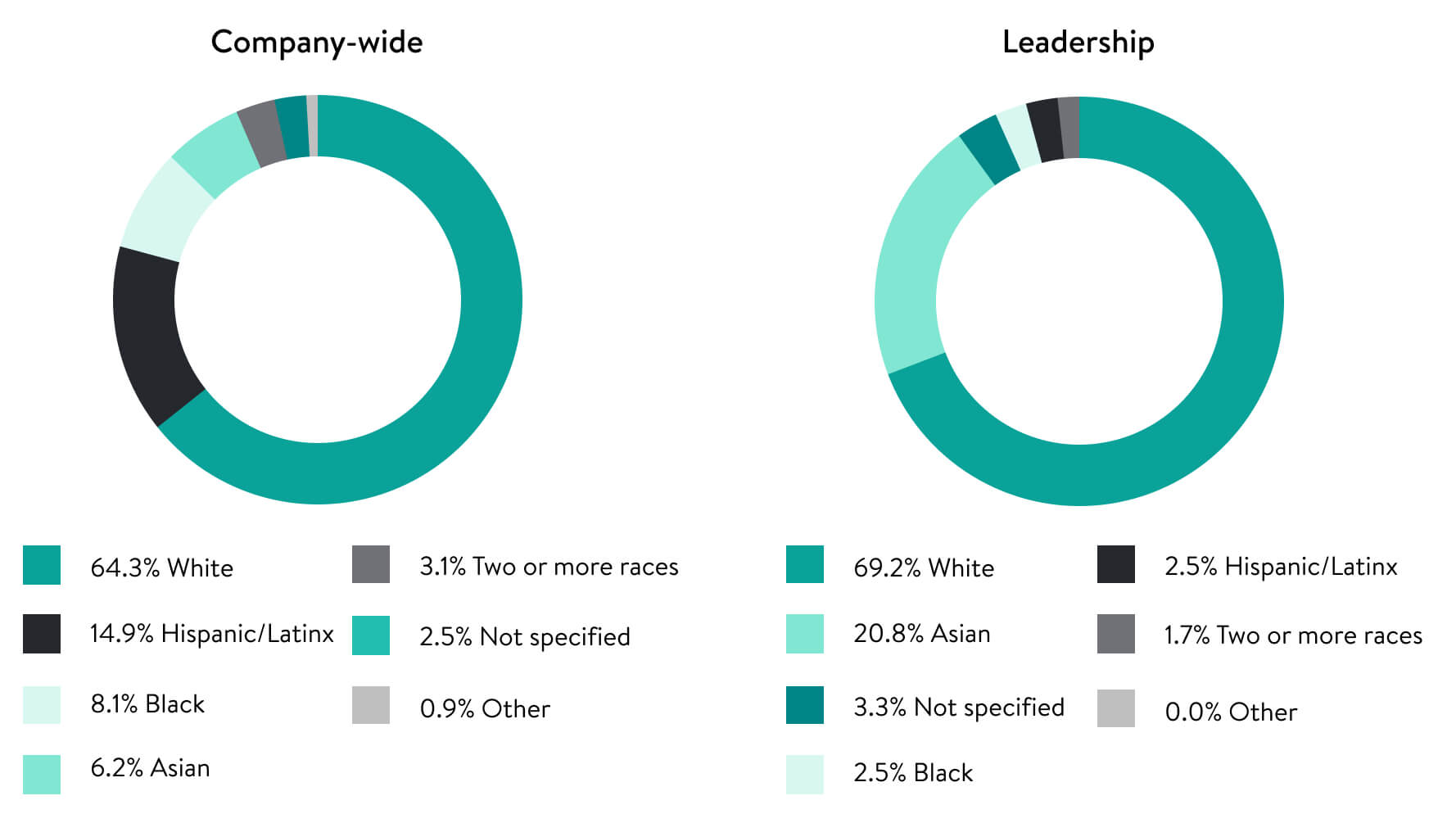
Data is U.S. only
Racial/Ethnic Representation by Department


Data is U.S. only
DC + CX: Distribution Centers and Customer Experience
Leadership Racial/Ethnic Representation by Department

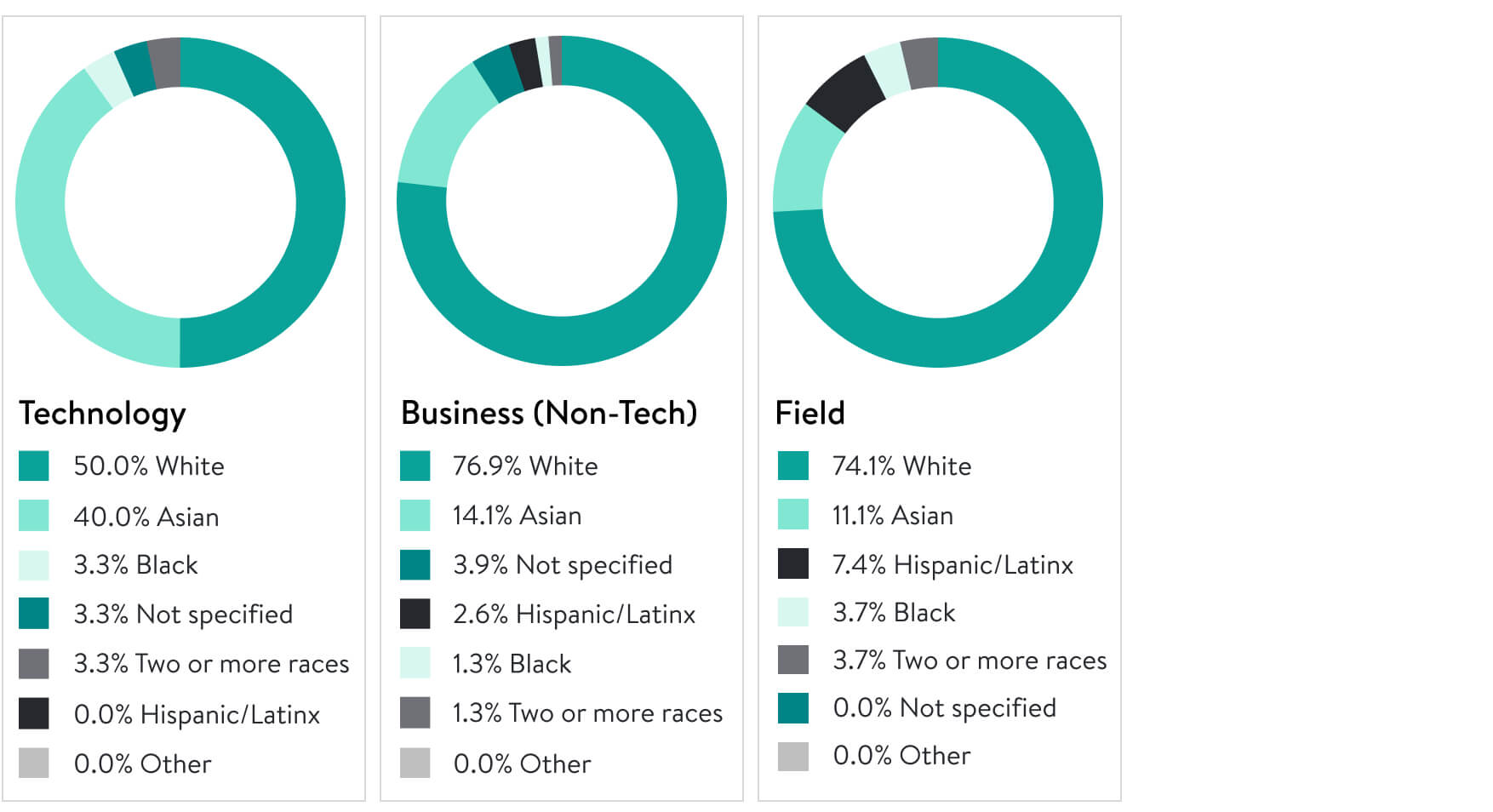
Data is U.S. only
Field: Styling, Distribution Centers and Customer Experience
As these numbers indicate, we do not have nearly enough Black or Latinx people working at Stitch Fix, especially within our corporate teams. This is not right, and needs to change. We know we aren’t alone in facing or tackling this challenge, and we are committed to doing the hard work.
We are dedicated to increasing Black, Indigenous and People of Color (BIPOC) representation and are putting a diversity, equity and inclusion strategy in place to do so. We are examining everything from our hiring practices, to the employee experience, to additional training and support for managers and creating more spaces for employees to learn and grow, to inserting more anti-racist and anti-bias mechanisms into our processes. Our goal is to use the full sphere of our influence to further diversify Stitch Fix because we know that diversity and representation in our community makes Stitch Fix better, our ideas stronger, and our experience more broadly resonant to the diverse client audience we serve.
Gender Representation
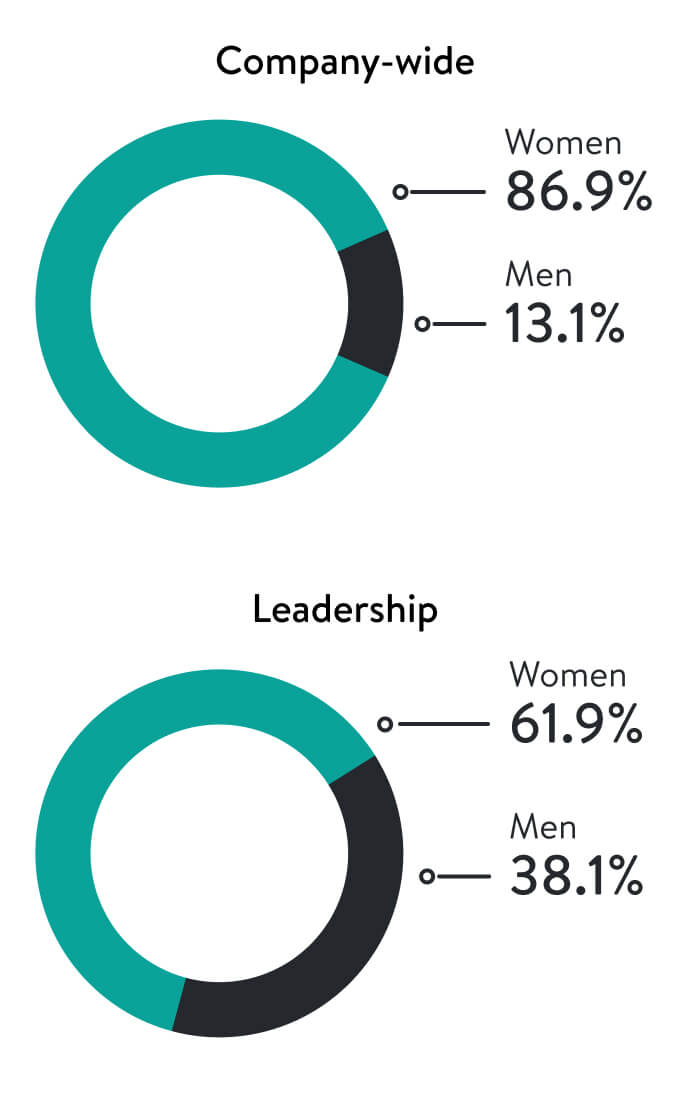
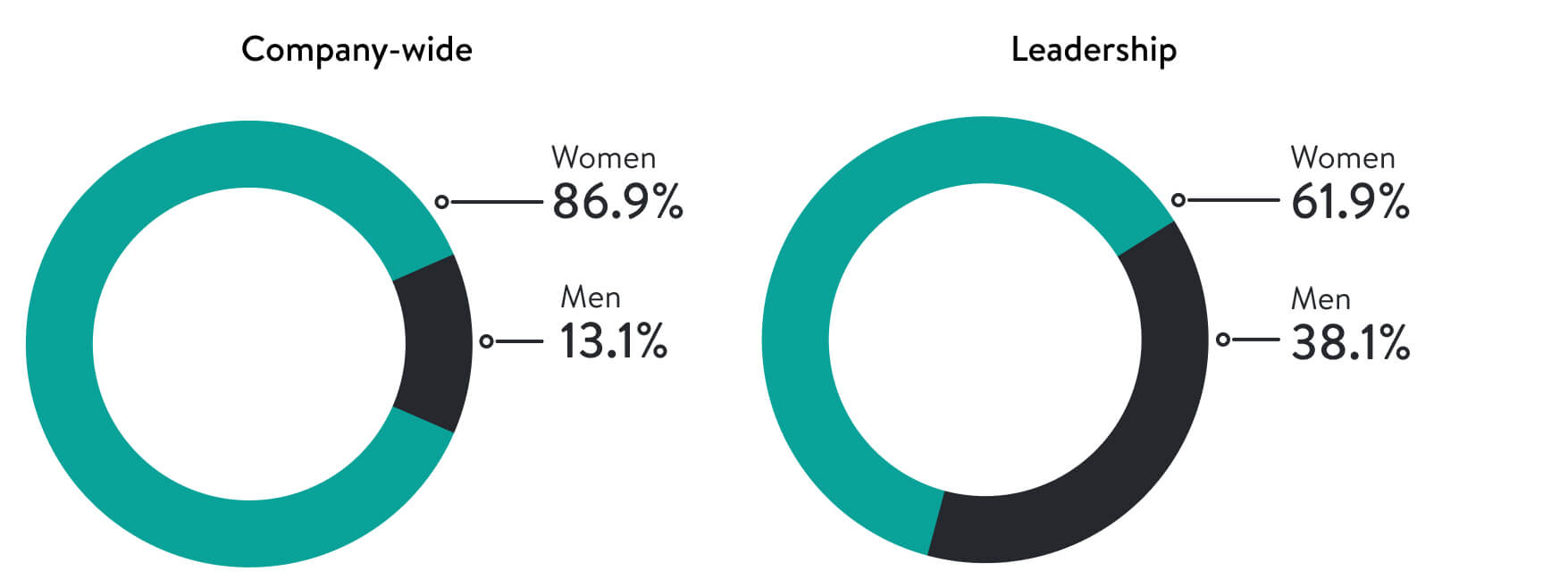
Gender Representation by Department
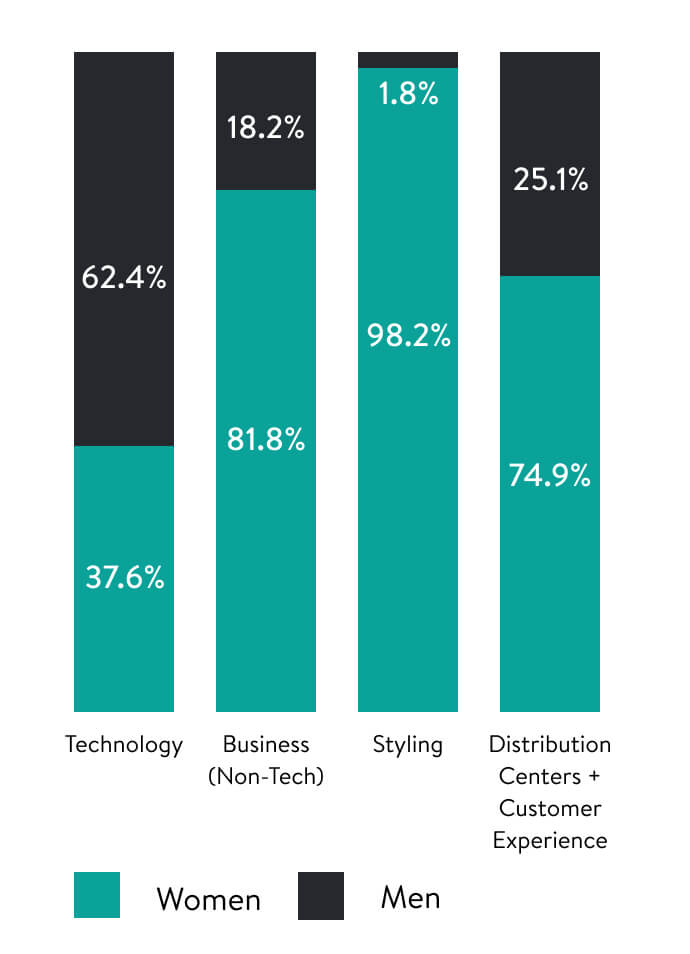

Leadership Gender Representation by Department
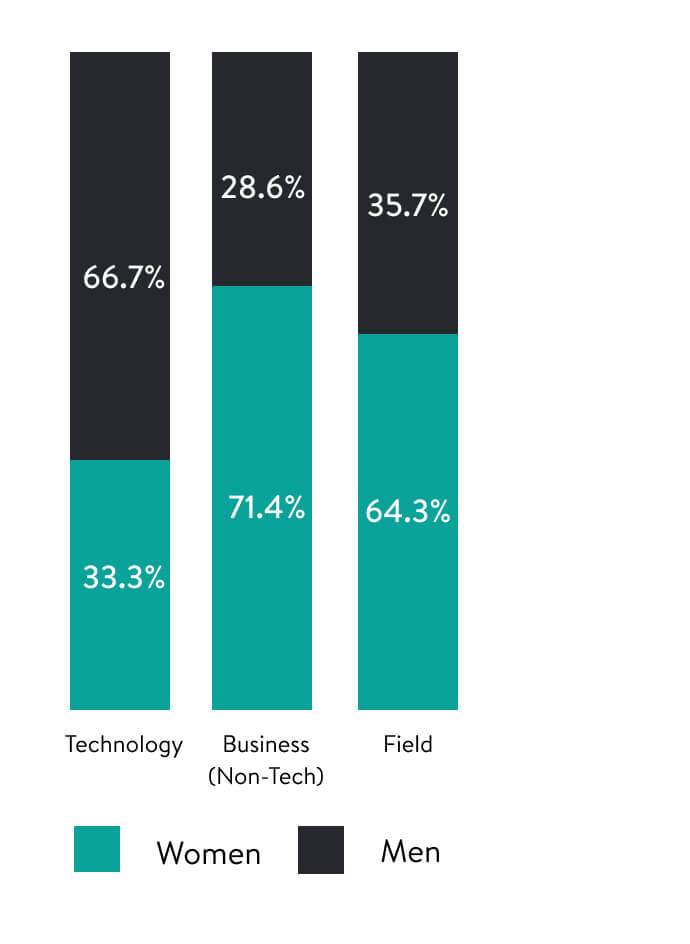

Field: Styling, Distribution Centers and Customer Experience
We are proud of the number of women working in our technical organization and in leadership positions across the company. (While not reflected above, our Board has also been recognized as being one of the most gender diverse of any public company.) We plan to dive deeper into how we’ve successfully attracted and retained this talent over the years, and leverage those learnings to make progress on racial diversity as well. Having a female Founder and CEO has made gender diversity an intentional focus from day one; we now need to bring the same level of focus to racial diversity.
In order to hold ourselves accountable to making progress, knowing this is a long-term process, we are currently at work setting a multiyear diversity goal. We want to be thoughtful and methodical in our approach, and galvanize our leaders and entire team around our objectives. We also plan to update our representation numbers annually every September alongside our Annual Company Report (starting next year), and discuss where we’ve made strides forward, where we haven’t, and why.
Pay Equity
Simply put, pay equity is equal pay for work of equal value. By paying employees fairly and consistently based on the role they perform, working conditions, and according to market data, companies can ensure that employees are not paid based on factors like gender, race, or ethnicity. We know these subjective factors can play a role in compensation, to the employee’s disadvantage or to their advantage.
At Stitch Fix, we established a system of equal pay from the beginning. We believe a fair and unbiased compensation structure is a critical component to drive a more inclusive culture within our own walls and beyond—and ultimately helps us attract and retain the highest caliber talent. It also means that we can sustain a system that creates less motivation for self-serving politics or individual goals, and creates intrinsic motivation to drive toward collective success and the happiness of our clients.
We recently retained an expert third party, Syndio, to audit our U.S. pay data. While we had confidence in our approach and philosophy, we wanted to ensure that our compensation system withstood external review applying appropriate and accepted methods and standards. The conversation around pay equity has been primarily rooted in gender biases, but we decided to also examine our pay through the lens of race, in addition to gender. The results showed there is no statistically significant difference in pay across gender and/or race at Stitch Fix.
Stitch Fix Pay Equity
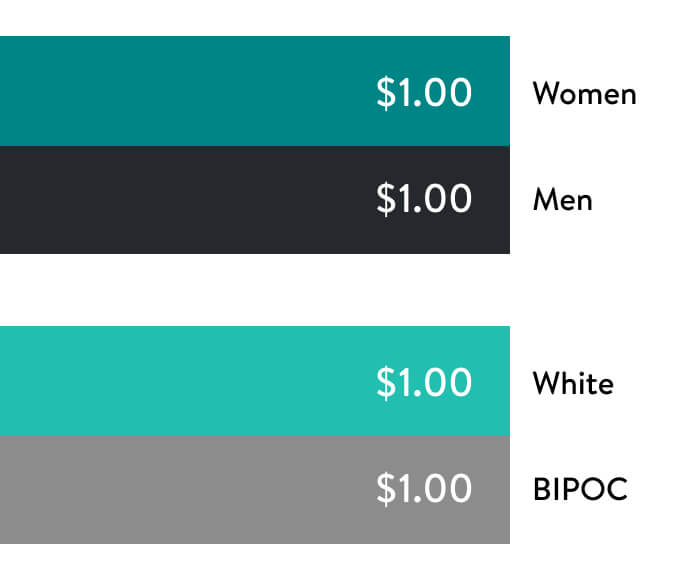

Women earn $1.00 for every $1.00 earned by comparable men. BIPOC employees earn $1.00 for every $1.00 earned by comparable white employees.
Going forward, we will continue to analyze these numbers each year, to ensure we maintain pay equity. In addition to sharing data, we also plan to share details of our approach and best practices with industry peers that want to consider implementing a pay equity structure.
While we have equal pay for work of equal value, other biases can impact pay. With that in mind, we need to continue to be vigilant and review areas like leveling and promotions in our organization to ensure that we are working to identify and mitigate any bias in these processes.
Supporting and Growing Black-Owned Apparel and Accessories Businesses
In reviewing our vendor base (more than 1,000 brands and partners), we were disappointed with how few Black-owned enterprises we currently work with. There’s significant work to do to promote a more equitable and diverse retail landscape, work that we are committed to being a part of. In order to accelerate change within our industry and our own vendor base, we made a commitment in June to pledge our resources to help seed, grow, mentor, and support diverse entrepreneurs, starting with a focus on Black-owned apparel and accessories companies.
Today, we’re excited to announce Elevate, a grant and mentorship program that will embody our art & science approach to support underrepresented entrepreneurs at an early stage of business growth. Elevate will award five recipients with cash grants of $25,000 each, the opportunity to participate in a mentorship program and to receive wholesale orders for their product to be sold on Stitch Fix’s platform. We will also provide participants with access to our data-driven insights to enable them to improve the product market fit of their designs. For the 2020-2021 cohort, the program will be focused on Black-owned companies/designers producing apparel and/or accessories. On October 1, we will share program details on our website, where applicants can learn more and submit their application. The grant program will formally kick off with the first cohort in January 2021.
Increasing Representation in Our Marketing
We have been working to increase the diversity of our models, both in terms of the representation of people of color as well as in body shapes and sizes, for the past year. In the last six months, 59% of our influencer imagery featured BIPOC. However, we know we need to do more than diversify our imagery and include more skin tones in our content—we must also amplify those voices. To help, we’re committing to:
- Launching an ambassador program with eight Black influencers. This effort started on July 10 and will include monthly posts, stories, and highlights from this group shared on our official Stitch Fix handles over the course of the next year.
- 60% of all our models, content creators, and influencers we partner with being BIPOC by the end of December 2020.
- Ensuring pay equity for all BIPOC talent both in front of and behind the camera. This is an area where there is significant industry-wide work to do and we are proud to be part of leading the way.
This is only the beginning of our work to better represent everybody (and every body) in our marketing, to ensure Stitch Fix is an experience where everyone is included.
Our financial investments in the Black community
We will donate $500,000 over the next five years ($100,000 annually) directly to organizations that support the advancement of social justice. More specifically, we are donating to organizations, including smaller nonprofits, that the Black Lives Matter Global Network Foundation supports and that are aligned with the Black Lives Matter movement.
Following are the social justice organizations that Stitch Fix will donate to this year.
- Advancement Project
- Ella Baker Center
- Mothers Against Police Brutality
- National Black Justice Coalition
- Women of Color Network
We will also be matching employee donations to these organizations, as well as to BLM Global Network Foundation or our partner The Atlanta Women’s Foundation, up to an additional $100,000.
Today’s update is one push forward in a long journey ahead. By contributing our voices, our work, and our community alongside the work of many, many others, we hope to be part of a sustaining movement that leads to real change. We have always been a company more focused on show than tell; we are committed to doing the “work of the work” within our own company and the communities we invest in, and being held accountable for our actions. Tackling issues of inequality is core to our mission, which is to inspire people to be their best selves, and we are dedicated to the movement.
Learn more about our approach here.

